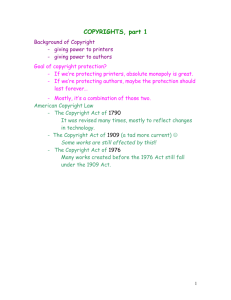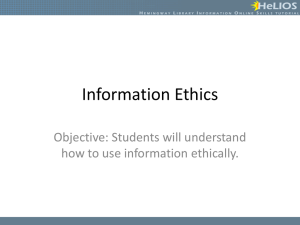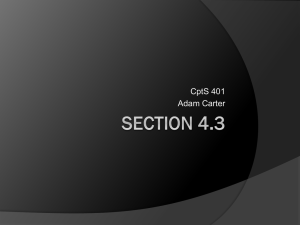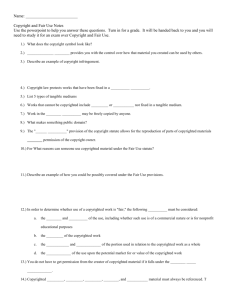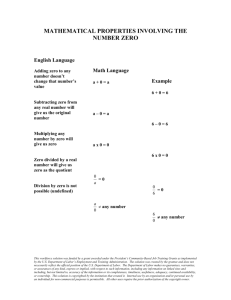Introduction to CATIA V5
advertisement
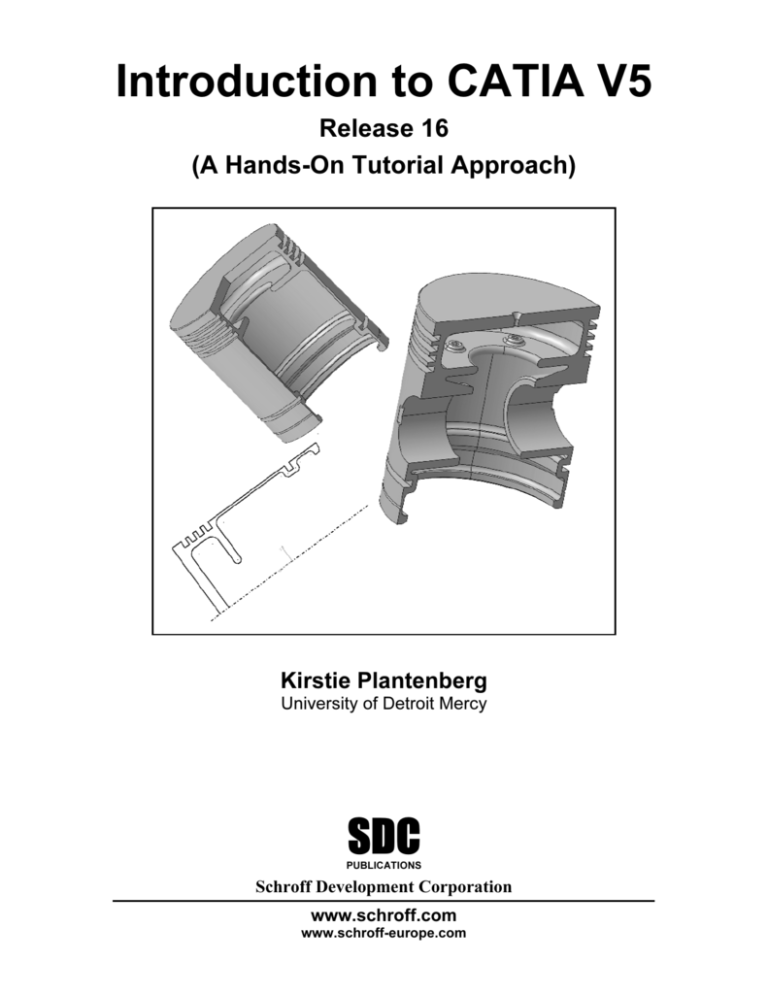
Introduction to CATIA V5 Release 16 (A Hands-On Tutorial Approach) Kirstie Plantenberg University of Detroit Mercy SDC PUBLICATIONS Schroff Development Corporation www.schroff.com www.schroff-europe.com Visit the following websites to learn more about this book: An Introduction to CATIA V5 Chapter 2: SKETCHER Copyrighted Chapter 2: SKETCHER Material Introduction Chapter 2 focuses on CATIA’s Sketcher workbench. The reader will learn how to sketch and constrain very simple to very complex 2D profiles. Copyrighted Material Tutorials Contained in Chapter 2 • • • • • • • Tutorial 2.1: Sketch Work Modes Tutorial 2.2: Simple Profiles & Constraints Tutorial 2.3: Advanced Profiles & Sketch Analysis Tutorial 2.4: Modifying Geometries & Relimitations Tutorial 2.5: Axes & Transformations Tutorial 2.6: Operations on 3D Geometries & Sketch planes Tutorial 2.7: Points & Splines Copyrighted Material Copyrighted Material 2-1 An Introduction to CATIA V5 Chapter 2: SKETCHER Copyrighted Material NOTES: Copyrighted Material Copyrighted Material Copyrighted Material 2-2 Chapter 2: SKETCHER: Tutorial 2.1 Copyrighted Chapter 2: SKETCHER Material Tutorial 2.1: Sketch Work Modes Copyrighted Material Featured Topics & Commands The Sketcher workbench The Sketch tools toolbar Part Modeled Section 1: Using Snap to Point Section 2: Using Construction Elements Section 3: Geometrical and Dimensional Constraints Section 4: Cutting the part by the sketch plane ........................... ........................... ........................... ........................... ........................... ........................... ........................... Copyrighted Material Prerequisite Knowledge & Commands • • • • Entering workbenches Entering and exiting the Sketcher workbench Drawing simple profiles Simple Pads and Pockets Copyrighted Material 2.1 - 1 2.1-2 2.1-3 2.1-4 2.1-4 2.1-7 2.1-9 2.1-11 Chapter 2: SKETCHER: Tutorial 2.1 Copyrighted Material The Sketcher Workbench The Sketcher workbench is a set of tools that helps you create and constrain 2D geometries. Features (pads, pockets, shafts, etc...) may then be created solids or modifications to solids using these 2D profiles. You can access the Sketcher workbench in various ways. Two simple ways are by using the top pull down menu (Start – Mechanical Design – Sketcher), or by selecting the Sketcher icon. When you enter the sketcher, CATIA requires that you choose a plane to sketch on. You can choose this plane either before or after you select the Sketcher icon. To exit the sketcher, select the Exit Workbench icon. Copyrighted Material The Sketcher workbench contains the following standard workbench specific toolbars. • Profile toolbar: The commands located in this toolbar allow you to create simple geometries (rectangle, circle, line, etc...) and more complex geometries (profile, spline, etc...). • Operation toolbar: Once a profile has been created, it can be modified using commands such as trim, mirror, chamfer, and other commands located in the Operation toolbar. Copyrighted Material • Constraint toolbar: Profiles may be constrained with dimensional (distances, angles, etc...) or geometrical (tangent, parallel, etc...) constraints using the commands located in the Constraint toolbar. • Sketch tools toolbar: The commands in this toolbar allow you to work in different modes which make sketching easier. • User Selection Filter toolbar: Allows you to activate different selection filters. Copyrighted Material 2.1 - 2 Chapter 2: SKETCHER: Tutorial 2.1 • Visualization toolbar: Allows you to, among other things to cut the part by the sketch plane and choose lighting effects and other factors that influence how the part is visualized. • Tools toolbar: Allows you to, among others other things, to analyze a sketch for problems, and create a datum. Copyrighted Material The Sketch tools Toolbar The Sketch tools toolbar contains icons that activate and deactivate different work modes. These work modes assist you in drawing 2D profiles. Reading from left to right, the toolbar contains the following work modes; (Each work mode is active if the icon is orange and inactive if it is blue.) • • • • • Copyrighted Material Grid: This command turns the sketcher grid on and off. Snap to Point: If active, your cursor will snap to the intersections of the grid lines. Construction / Standard Elements: You can draw two different types of elements in CATIA a standard element and a construction element. A standard element (solid line type) will be created when the icon is inactive (blue). It will be used to create a feature in the Part Design workbench. A construction element (dashed line type) will be created when the icon is active (orange). They are used to help construct your sketch, but will not be used to create features. Geometric Constraints: When active, geometric constraints will automatically be applied such as tangencies, coincidences, parallelisms, etc... Dimensional Constraints: When active, dimensional constraints will automatically be applied when corners (fillets) or chamfers are created, or when quantities are entered in the value field. The value field is a place where dimensions such as line length and angle are manually entered. Copyrighted Material Copyrighted Material 2.1 - 3 Chapter 2: SKETCHER: Tutorial 2.1 Copyrighted Material Part Modeled The part modeled in this tutorial is shown below. The part is constructed with the assistance of different work modes. Copyrighted Material Section 1: Using Snap to Point 1) Open a New Part drawing and name the part Spline Shape. Copyrighted Material 2) Enter the Sketcher on the yz plane. 3) Restore the default positions of the toolbars (Tools – Customize... – Toolbars tab – Restore position.) Move the Sketch Tools toolbar and the User Selection Filter toolbar to the top toolbar area. Copyrighted Material 2.1 - 4 Chapter 2: SKETCHER: Tutorial 2.1 Copyrighted Material 4) Set your grid spacing. At the top pull down menu, select Tools – Options... In the Options window, expand the Mechanical Design portions of the left side navigation tree and select Sketcher. Activate the options Display, Snap to point, and Allow Distortions in the Grid section on the right side. Set your Primary spacing and Graduations to H: 100 mm and 20, and V: 100 mm and 10. Copyrighted Material Copyrighted Material 5) Select the Spline side toolbar area. icon. This is located in the Profile toolbar in the right 6) Move your cursor around the screen. Note that it snaps to the intersections of the grid. Your Snap to Point should be orange (active). Deactivate the Snap to Point icon by clicking on it and turning it back to blue. Move your cursor around the screen and notice the difference. Copyrighted Material 2.1 - 5 Chapter 2: SKETCHER: Tutorial 2.1 Copyrighted Material 7) Reactivate the Snap to Point icon and draw the spline shown. Select each point (indicated by a number in a square) in order from 1 to 7, double clicking at the last point to end the spline command. 8) Edit the spline by double clicking on any portion of it. 2 1 7 3 4 6 Copyrighted Material 9) In the Spline Definition window, select CtrlPoint.7, then activate the Tangency option, and select OK. Notice that the last point is now tangent to the first point. 5 Copyrighted Material 10) Draw a Circle as shown. inside the spline Copyrighted Material 2.1 - 6 Chapter 2: SKETCHER: Tutorial 2.1 Copyrighted Material 11) Exit the Sketcher to a length of 50 mm. and Pad the sketch Copyrighted Material Section 2: Using construction elements. 1) Deselect all. 2) Enter the Sketcher face of the part. on the front Sketch face Copyrighted Material 3) Activate the Construction / Standard Elements orange. icon. It should be 4) Deselect all. Hit the Esc key twice. 5) Project an outline of the part onto the sketch plane. Select the Project 3D Elements icon then select the face of the part. This icon is located in the Operations toolbar near the bottom of the right side toolbar area. It may be hidden in the bottom right corner. Copyrighted Material 6) Deselect all. The projection should now be yellow (this means it is associated with the part and will change with the part) and dashed (this means it is a construction element). 2.1 - 7 Chapter 2: SKETCHER: Tutorial 2.1 Copyrighted Material 7) At the top pull down window, select Tools – Options – Sketcher tab. Deactivate the Grid Display and Snap to Point options. Select OK. Copyrighted Material 8) Deactivate the Construction / Standard Elements icon. command to draw the triangle shown. The points of the 9) Using the Profile triangle should lie on the projected construction element. You will know when you are on the projection when a symbol of two concentric circles appears, and you will know when you are snapped to the endpoint of the start point when a symbol of two concentric circles appears and the inner one is filled. Copyrighted Material Copyrighted Material 2.1 - 8 Chapter 2: SKETCHER: Tutorial 2.1 Copyrighted Material 10) Exit the Sketcher to a length of 10 mm. and Pad the sketch Copyrighted Material Section 3: Geometrical and Dimensional Constraints 1) Deselect all. 2) Enter the Sketcher on the front large face of the part. Copyrighted Material 3) Activate the Geometrical Constraints orange. icon. It should be Sketch face 4) At the top pull down window, select Tools – Options – Sketcher. Under the Constraint portions of the window, select SmartPick... The SmartPick window shows all the geometrical constraints that will be created automatically. These constraints may be turn on and off depending on your design/sketch needs. Close both the Smart Pick and Options windows. Copyrighted Material 2.1 - 9 Chapter 2: SKETCHER: Tutorial 2.1 Copyrighted Material 5) Draw a Rectangle to the right of the hole as shown. Notice that geometric constraints (H = horizontal, V = Vertical) are automatically applied. 6) Deactivate the Geometrical Constraints should be blue. icon. It Copyrighted Material 7) Draw a Rectangle to the left of the hole as shown. Notice that no geometric constraints are made. Click and drag the corner point. 8) For each rectangle, click on one of the points defining a corner and move it using the mouse. Notice the difference between the two. This is due to the horizontal and vertical constraints that were applied to the one rectangle. 9) Undo (CTRL + Z) the moves until the original rectangles are back. Copyrighted Material 10) Exit the Sketcher and Pocket sketch using the Up to last option. the Copyrighted Material 11) Expand the specification tree to the sketch level. 2.1 - 10 Chapter 2: SKETCHER: Tutorial 2.1 Copyrighted Material 12) Edit Sketch.3 (the sketch associated with the pocket). In the specification tree, double click on Sketch.3, or right click on it and select Sketch.3 object Edit. You will automatically enter the sketcher on the sketch plane used to create this sketch. 13) Activate the Dimensional Constraint icon. It should be orange. icon, select 14) Select the Corner the bottom left corner point of the left rectangle, move your mouse up and to the right, and click. A corner or fillet will be created. The corner icon is located in the Operations toolbar near the bottom of the right side toolbar area. The corner/fillet may also be created by Corner point selecting the two lines that create the corner. Notice that a dimension is automatically created. Copyrighted Material 15) Deactivate the Dimensional Constraint icon. It should be Copyrighted Material blue. Create a Corner in the upper right corner of the same rectangle. Notice that this time no dimensional constraint was created. 16) Exit the Sketcher . We have changed the sketch used to create the pocket. Notice that the pocket is automatically updated to reflect these changes. Copyrighted Material Section 4: Cutting the part by the sketch plane. Sometimes it is necessary to sketch inside the part. The Cut Part by Sketch Plane command allows you to see inside the part and makes it easier to draw and constrain your sketch. 1) Enter the Sketcher on the xy plane. 2.1 - 11 Chapter 2: SKETCHER: Tutorial 2.1 Copyrighted Material 2) Select the Isometric View area. icon. This icon is located in the bottom toolbar 3) Select the Cut Part by Sketch Plane icon located in the bottom toolbar area. The part in now cut by the xy plane (the sketch plane). Copyrighted Material 4) Select the Top view icon and draw a Circle in the middle of the hole as shown in the figure. 5) Exit the Sketcher . 6) Select the Pad icon and then select the More>> button. Fill in the following fields for both the First and Second Limits; Type: Up to surface, Limit: Select the inner circumference of the hole, and Selection: Sketch.4 (the circle). Select Preview to see if the Pad will be applied correctly, and then OK. Copyrighted Material Copyrighted Material 2.1 - 12 Chapter 2: SKETCHER: Tutorial 2.2 Copyrighted Chapter 2: SKETCHER Material Tutorial 2.2: Simple Profiles & Constraints Copyrighted Material Featured Topics & Commands Profile toolbar Constraints toolbar Selecting icons Part Modeled Section 1: Creating circles. Section 2: Creating dimensional constraints. Section 3: Creating lines. Section 4: Creating geometrical constraints. Section 5: Creating arcs. ......................................... ......................................... ......................................... ......................................... ......................................... ......................................... ......................................... ......................................... ......................................... Copyrighted Material Prerequisite Knowledge & Commands • • • • Entering workbenches Entering and exiting the Sketcher workbench Simple Pads Work modes (Sketch tools toolbar) Copyrighted Material 2.2 - 1 2.2-2 2.2-5 2.2-5 2.2-6 2.2-6 2.2-7 2.2-8 2.2-11 2.2-14 Chapter 2: SKETCHER: Tutorial 2.2 Copyrighted Material Profile toolbar The Profile toolbar contains 2D geometry commands. These geometries range from the very simple (point, rectangle, etc...) to the very complex (splines, conics, etc...). The Profile toolbar contains many sub-toolbars. Most of these subtoolbars contain different options for creating the same geometry. For example, you can create a simple line, a line defined by two tangent points, or a line that is perpendicular to a surface. Reading from left to right, the Profile toolbar contain the following commands. Copyrighted Material Copyrighted Material Profile toolbar • • • • • • • Profile: This command allows you to create a continuous set of lines and arcs connected together. Rectangle / Predefined Profile toolbar: The default top command is rectangle. Stacked underneath are several different commands used to create predefined geometries. Circle / Circle toolbar: The default top command is circle. Stacked underneath are several different options for creating circles and arcs. Spline / Spline toolbar: The default top command is spline which is a curved line created by connecting a series of points. Ellipse / Conic toolbar: The default top command is ellipse. Stacked underneath are commands to create different conic shapes such as a hyperbola. Line / Line toolbar: The default top command is line. Stacked underneath are several different options for creating lines. Axis: An axis is used in conjunction with commands like mirror and shaft (revolve). It defines symmetry. It is a construction element so it does not become a physical part of your feature. Copyrighted Material 2.2 - 2 Chapter 2: SKETCHER: Tutorial 2.2 • Copyrighted Material Point / Point toolbar: The default top command is point. Stacked underneath are several different options for creating points. Predefined Profile toolbar Predefined profiles are frequently used geometries. CATIA makes these profiles available for easy creation which speeds up drawing time. Reading from left to right, the Predefined Profile toolbar contains the following commands. • • • • • • • • • Rectangle: The rectangle is defined by two corner points. The sides of the rectangle are always horizontal and vertical. Oriented Rectangle: The oriented rectangle is defined by three corner points. This allows you to create a rectangle whose sides are at an angle to the horizontal. Parallelogram: The parallelogram is defined by three corner points. Elongated Hole: The elongated hole or slot is defined by two points and a radius. Cylindrical Elongated Hole: The cylindrical elongated hole is defined by a cylindrical radius, two point and a hole radius. Keyhole Profile: The keyhole profile is defined by two center points and two radii. Hexagon: The hexagon is defined by a center point and the radius of an inscribed circle. Centered Rectangle: The centered rectangle is defined by a center point and a corner point. Centered Parallelogram: The centered parallelogram is defined by a center point (defined by two intersecting lines) and a corner point. Copyrighted Material Copyrighted Material Circle toolbar The Circle toolbar contains several different ways of creating circles and arcs. Reading from left to right, the Circle toolbar contains the following commands. • • • • Circle: A circle is defined by a center point and a radius. Three Point Circle: The three point circle command allows you to create a circle using three circumferential points. Circle Using Coordinates: The circle using coordinates command allows you to create a circle by entering the coordinates for the center point and radius in a Circle Definition window. Tri-Tangent Circle: The tri-tangent circle command allows you to create a circle whose circumference is tangent to three chosen lines. Copyrighted Material 2.2 - 3 Chapter 2: SKETCHER: Tutorial 2.2 • • • Copyrighted Material Three Point Arc: The three point arc command allows you to create an arc defined by three circumferential points. Three Point Arc Starting With Limits: The three point arc starting with limits allows you to create an arc using a start, end, and midpoint. Arc: The arc command allows you to create an arc defined by a center point, and a circumferential start and end point. Spline toolbar Reading from left to right, the Spline toolbar contains the following commands. • • Spline: A spline is a curved profile defined by three or more points. The tangency and curvature radius at each point may be specified. Connect: The connect command connects two points or profiles with a spline. Copyrighted Material Conic toolbar Reading from left to right, the Conic toolbar contains the following commands. • • • • Ellipse: The ellipse is defined by center point and a major and minor axis points. Parabola by Focus: The parabola is defined by a focus, apex and a start and end point. Hyperbola by Focus: The hyperbola is defined by a focus, center point, apex and a start and end point. Conic: There are several different methods that can be used to create conic curves. These methods give you a lot of flexibility when creating above three types of curves. Line toolbar Copyrighted Material The Line toolbar contains several different ways of creating lines. Reading from left to right, the Line toolbar contains the following commands. • • • • • Line: A line is defined by two points. Infinite Line: Creates infinite lines that are horizontal, vertical or defined by two points. Bi-Tangent Line: Creates a line whose endpoints are tangent to two other elements. Bisecting Line: Creates an infinite line that bisects the angle created by two other lines. Line Normal to Curve: This command allows you to create a line that starts anywhere and ends normal or perpendicular to another element. Copyrighted Material 2.2 - 4 Chapter 2: SKETCHER: Tutorial 2.2 Copyrighted Material Point toolbar The Point toolbar contains several different ways of creating points. Reading from left to right, the Point toolbar contains the following commands. • • • • • Point by Clicking: Creates a point by clicking the left mouse button. Point by using Coordinates: Creates a point at a specified coordinate point. Equidistant Points: Creates equidistant points along a predefined path curve. Intersection Point: Creates a point at the intersection of two different elements. Projection Point: Projects a point of one element onto another. Copyrighted Material Constraint toolbar Constraints can either be dimensional or geometrical. Dimensional constraints are used to constrain the length of an element, the radius or diameter of an arc or circle, and the distance or angle between elements. Geometrical constraints are used to constrain the orientation of one element relative to another. For example, two elements may be constrained to be perpendicular to each other. Other common geometrical constraints include parallel, tangent, coincident, concentric, etc... Reading from left to right: • • • • • • • Copyrighted Material Constraints Defined in Dialoged Box: Creates geometrical and dimensional constraints between two elements. Constraint: Creates dimensional constraints. Contact Constraint: Creates a contact constraint between two elements. Fix Together: The fix together command groups individual entities together. Auto Constraint: Automatically creates dimensional constraints. Animate Constraint: Animates a dimensional constraint between to limits. Edit Multi-Constraint: This command allows you to edit all your sketch constraints in a single window. Copyrighted Material Selecting icons When an icon is selected, it turns orange indicating that it is active. If the icon is activated with a single mouse click, the icon will turn back to blue (deactivated) when the operation is complete. If the icon is activated with a double mouse click, it will remain active until another command is chosen or if the Esc key is hit twice. 2.2 - 5 Chapter 2: SKETCHER: Tutorial 2.2 Copyrighted Material Part Modeled The part modeled in this tutorial is shown on the right. This part will be created using simple profiles, circles, arcs, lines, and hexagons. The geometries are constrained to conform to certain dimensional (lengths) and geometrical constraints (tangent, perpendicular, etc...). Section 1: Creating circles. (Hint: If you get confused about how to apply the different commands that are used in this tutorial, read the prompt line for additional help.) Copyrighted Material 1) Launch CATIA V5, enter the Part Design workbench and, if asked, name your part Post. 2) Enter the Sketcher plane. on the zx 3) Set your grid spacing to be 100 mm with 10 graduations, activate the Snap to point, and activate the geometrical and dimensional constraints. (Tools – Options...) Copyrighted Material Duplicate the settings shown. Copyrighted Material 2.2 - 6 Chapter 2: SKETCHER: Tutorial 2.2 Copyrighted Material 4) Pull out the Circle toolbar 5) Double click on the Circle draw the circles shown. . icon and 6) Exit the Sketcher and Pad the sketch to 12 mm on each side (Mirrored extent). Notice that the inner circle at the bottom becomes a hole. Copyrighted Material Section 2: Creating dimensional constraints. Copyrighted Material 1) Expand your specification tree to the sketch level. 2) Edit Sketch.1. To edit a sketch you can double click on the sketch name in the specification tree, or you can right click on the name select Sketch.1 - Edit. CATIA automatically takes you into the sketcher on the plane used to create Sketch.1. 3) Double click on the Constraints icon. Copyrighted Material 4) Select the border of the upper circle, pull the dimension out and click your left mouse button to place the dimension. Repeat for the two bottom circles. 5) Select the center point of the upper circle, then the center point of the lower circles, pull the dimension out and click. 2.2 - 7 Chapter 2: SKETCHER: Tutorial 2.2 Copyrighted Material 6) Double click on the D20 dimension. In the Constraint Definition window, change the diameter from 20 to 16 mm. D48 140 7) In a similar fashion, change the other dimensions to the values shown in the figure. Copyrighted Material D16 D32 8) Exit the Sketcher and deselect all. Notice that the part automatically updates to the new sketch dimensions. Section 3: Creating lines. 1) Enter the Sketcher on the zx plane. 1 3 Copyrighted Material 2) Deactivate the Snap to Point icon. 3) Project the two outer circles of the part onto the sketch plane. Double click on the Project 3D Elements icon. This icon is located in the lower half of the right side toolbar area. Select the outer edges of the two cylinders. 4) Pull out the line toolbar . Copyrighted Material 5) Double click on the Bi-Tangent Line icon. Select the points, in order, as indicated on the figure. 2.2 - 8 2 4 Chapter 2: SKETCHER: Tutorial 2.2 Copyrighted Material 6) Pull out the Relimitations toolbar Operation toolbar. located in the Projected edge Trimmed edge 7) Double click on the Quick trim icon. Select the outer portion of the projected circles. Notice that the trimmed projection turns into a construction element (dashed). 1 3 Copyrighted Material 8) Exit the Sketcher and Pad the sketch to 6 mm on each side (Mirrored extent). Projected edge Copyrighted Material 2 Trimmed edge Copyrighted Material 2.2 - 9 4 Chapter 2: SKETCHER: Tutorial 2.2 Copyrighted Material 9) Enter the Sketcher on the zx plane. icon (it should be 10) Activate the Construction/Standard Element orange). 11) Select the Project 3D Elements icon and then project the left line of the part as shown in the figure. Copyrighted Material 12) Activate your Snap to Point icon. 13) Draw a line that starts at point 1 (see fig.) and ends normal/perpendicular to projected line using the Line Normal to Curve Projected line icon. Normal line 1 14) Deactivate your Snap to Point icon. Copyrighted Material Bisecting line 15) Draw a Line point 2. from point 1 to 16) Draw a line that bisects the previous 2 lines using the Bisecting Line icon. Read the prompt line for directions. 2 17) Deselect all. Copyrighted Material 18) Deactivate the Construction/Standard Element now). 2.2 - 10 icon (it should be blue Chapter 2: SKETCHER: Tutorial 2.2 Copyrighted Material 19) Draw a circle that is tangent to the projected line, normal line and bisecting line using the Tri-Tangent Circle prompt line for directions. icon. Read the Copyrighted Material 20) Zoom in on the circle. 21) Using Profile , draw the three additional lines shown in the figure. Copyrighted Material 22) Use the Quick Trim command to trim off the inside portion of the circle as shown. You will have to apply the quick trim operation twice. 23) Draw a Hexagon that has the same center as the circle/arc and is the approximate size shown in the figure. The Hexagon icon is usually stacked under the Rectangle icon. (Your hexagon will contain many constraints that are not shown in the figure.) Copyrighted Material 24) Deselect all. 2.2 - 11 Chapter 2: SKETCHER: Tutorial 2.2 Copyrighted Material 25) Apply a dimensional Constraint to the distance between the flats of the hexagon as shown. To create this constraint, select the top line and then the bottom line. Double click on the dimension and change its value to 7 mm. 26) Exit the Sketcher and Copyrighted Material Pad the sketch to a length of 2 mm on each side (Mirrored extent). Copyrighted Material Section 4: Creating constraints. geometrical 1) Enter the Sketcher on the flat face of the large cylinder. Sketch face Copyrighted Material 2.2 - 12 7 Chapter 2: SKETCHER: Tutorial 2.2 Copyrighted Material 2) Deactivate the Geometrical Constraint icon (it should be blue). This will allow you to create profiles with no automatically applied constraints. 3) On the face of the large cylinder, draw the Profile shown. No geometrical constraints should be indicated. Horizontal constraint Vertical constraint Parallel constraint Copyrighted Material 4) Deselect all. Perpendicular constraint 5) Reactivate the Geometrical Constraints icon (it should be orange). 6) Apply a vertical constraint to the right line of the profile by right clicking on it and selecting Line.? object – Vertical. 7) Apply a horizontal constraint to the top line using a similar procedure. Copyrighted Material 8) Deselect all. 9) Apply a perpendicular constraint between the right and bottom line of the profile. Hold the CTRL key down and select the left and bottom lines. Select the Constraints Defined in Dialog Box icon. In the Constraint Definition window, check the box next to Perpendicular and then select OK. 10) Apply a parallel constraint between the left and right lines of the profile in a similar way. Copyrighted Material 2.2 - 13 Chapter 2: SKETCHER: Tutorial 2.2 Copyrighted Material 11) Apply Constraints to the rectangle and change their values to the values shown in the figure. 20 14 Copyrighted Material 12) Apply the additional dimensional constraints shown in order to position the rectangle. Select the Constraints icon, then the circumference of the circle and then the appropriate side of the rectangle. Notice that once all the constraints are applied, the rectangle turns green indicating that it is fully constrained. If it did not turn green make sure the Visualization of diagnosis is activated in the Options window. (Tools – Options…) 14 Copyrighted Material 17 13) Draw the triangle shown using the Profile command. When drawing the triangle make sure that the top point is aligned with the origin ( ) and the bottom line is horizontal (H). Copyrighted Material 2.2 - 14 Chapter 2: SKETCHER: Tutorial 2.2 Copyrighted Material 14) Constrain the vertical height of the triangle to be 6 mm. Select the Constraints icon, select the one of the angled lines of the triangle, right click and select Vertical Measure Direction. 4 4 6 8 15) Constrain the rest of the triangle as shown. Copyrighted Material 16) Exit the Sketcher a length of 5 mm. and Pad the sketch to Copyrighted Material Section 5: Creating arcs. 1) Enter the Sketcher middle section. on the front face of the Copyrighted Material 2.2 - 15 Sketch face Chapter 2: SKETCHER: Tutorial 2.2 Copyrighted Material 2) Activate the Construction/Standard Element icon. 3) Select the Project 3D Elements icon and then project the front face of the middle section. 4) Deselect all. 5) Deactivate the Construction/Standard Element icon. Copyrighted Material 6) Activate your Snap to Point icon. 7) Draw the profile shown. Use the Three Point Arc command to create the bottom arc, the Arc command to create the top arc. The Arc icons are stacked under the Circle icon. For assistance in creating the arcs, read the prompt line at the bottom of the graphics screen. Use Copyrighted Material the Profile lines. command to create the connecting Arc Center point for arc Copyrighted Material Three point arc 2.2 - 16 Chapter 2: SKETCHER: Tutorial 2.2 Copyrighted Material 8) Exit the Sketcher a length of 30 mm. and Pad the sketch to Copyrighted Material 9) Deselect all. 10) Mirror the entire solid. Select the Mirror icon in the Transformation Features toolbar. Select the mirror element/face. In the Mirror Definition window select OK. Copyrighted Material Copyrighted Material Mirroring element 2.2 - 17
